#I picked up the visual novel I started in 2019 again and have coded like........... a good quarter of it while hepped up on caffeine
Explore tagged Tumblr posts
Text
turns out the solution to creative fatigue is a) sleep deprivation and b) luring a friend onto the project with you
#I picked up the visual novel I started in 2019 again and have coded like........... a good quarter of it while hepped up on caffeine#I ALSO relentlessly bullied a friend into working with me on it again which has made it so much less agonising#every creative person needs someone along for the ride to combat The Agonies#I'm having fun!!!! it's been so long and I'm having fun#I've had to change literally everything about the project but even that!! even the changing of things!! that is fun!#I forgot that creativity was meant to be. enjoyable.#BUT ALSO it is 2am. I can't deny how very 2am it is. this appears to be essential for some reason.
6 notes
·
View notes
Text
Fred Wood’s Game of the Year 2022 List
Here’s an organized list of my games of the year, 2022. The rules are simple: I must have completed the meat of the game for the first time in 2022. Release date doesn't matter to me. Nothing matters. Time is made up. We’re posting this on Tumblr in 2023. Nothing could possibly matter anymore.
Chaos;Head NOAH
I adore the Steins;Gate series and have picked up and supported every english release of every Science;Adventure visual novel that has released since. Chaos;Head NOAH is the first game that has completely disappointed me, and I’m not totally sure who’s fault that is. From what I understand the localization team on this release did some work to try and make the game more palatable to unfamiliar audiences, trying to make the main character less of a piece of shit than in the original release. Well, they failed. He sucks bad, and I’m not sure I can endure revisiting it again to find the other endings/routes, no matter how much better they make the story.
AI The Somnium Files: Nirvana Initiative
AI The Somnium Files: Nirvana Initiative is a sequel to AI The Somnium files, and is not as good. It tries to do some really wild things with its narrative and mostly succeeds, but they tried to make the game stand alone for folks who didn’t pick up the original, and I think that fear made it much less impactful. The inclusion of an Easy Mode for folks who want to binge the story and not deal as much with the clever puzzles made it much more pleasant for this dummy to enjoy.
13 Sentinels Aegis Rim (Nintendo Switch)
In 2019 13 Sentinels dropped on PS4 and I tried to play it and kept thinking “I wish I could play this on a handheld”, so I never finished it. This year I did, and while I was not as in love with it as all the folks in 2019 who extolled its virtues, I will say this is a very wild game that tells a wild story using a wild structure that seems incomprehensible until it clicks. And I think it clicks really, really well.
AI The Somnium Files
This game was the first new big drop from the creator of The Nonary Games series. I first played it a little on Switch when it first came out thanks to a review code, but the graphics were so bad and the beginning was so slow that I put it down and never picked it back up. When the sequel, Nirvana Initiatve came out, and friends started speaking so highly about it, I gave the original another try, this time on XBox Series X via GamePass. Instead of being a garbled mess, it was a gorgeous video game that held a great series of mysteries with a cast of characters I learned to love. The only mark against the game is it’s a bit hard. The puzzles in the game are based on dream logic, and dream logic is pretty subjective, so I kept failing and getting frustrated. The sequel mitigates this with lots of difficulty options and making it easier to retry. For this one I mitigated the difficulty by using a walkthrough when I got stuck. The game’s a real 9/10, though, highly recommended.
Undertale: No Mercy
Undertale came out in 2015, and here in 2022/2023 I’m working for Toby Fox on Deltarune, so take everything I have to say with a healthy amount of bias.
I played Undertale in 2015 the week it came out for a few minutes and thought it was cool and didn’t pick it back up until Thanksgiving. By that point the game had absolutely changed the internet forever and it was getting real hard not to get spoiled, so I played the game like I think most uninformed players do. I loaded up the game, thought it was neat, killed the really nice goat lady, learned that I did not have to kill goat mom, restarted the game, got a “pacifist ending”, then got a “true pacifist ending”. I had always heard about the other major route, but never really thought it would be my bag.
This year, after having talked to a lot of people and being pretty bad at the Undertale and Deltarune danmaku bullet patterns, I wanted to go and see the rest of what one of my favorite games of all time had to offer. I did it on a couple of Live Streams where I struggeled a lot, but ultimately won the battle against a true hero. I pushed on to give the friendly skeleton fight a few honest tries, before giving up and resorting to cheat engine.
Just like everyone else has said over the last seven years, it’s amazing how Toby was able to tell another very powerful and very memorable story by reusing places, characters, and battles. It’s wild how the most famous track in the game takes place in a battle that most players will never experience on their own. It reminds me of how the best part of Drakengard is hidden away after having to do a bunch of really horrible and actively unfun things, but that wild alternate route resulted in NieR.
I will probably never beat the friendly skeleton battle at the end of the game legitimately. I don’t have the kind of reflexes and memory to learn every single one of the attacks and pull them off, but having gotten there on my own and trying it a few times, I sure as hell understand and appreciate it.
The Stanley Parable: Ultra Deluxe
Many years ago I played a game that told the story of a man named Stanley. While The Stanley Parable: Ultra Deluxe is not quite a sequel (though it also very much is), it was wonderful to revisit one of my favorite indie games of all time with a fresh coat of paint on modern consoles. The new stuff was wonderfully meta and hilarious, and there was enough of it to justify the double dip. The extra nice thing was playing it with my wife this time, so I got to see bits of the game through fresh eyes.
Sonic Frontiers
Who would have thought that Breath of the Wild meets Death Stranding would make for a surprisingly competent open world Sonic the Hedgehog video game. I really liked running around each of the “open zones”, pulling off tricks and goin’ fast. The combat was repetitive, and the bosses weren’t terribly fun, but the moment to moment controlling the blue attitude man felt really great. Also the game has simultaneously some of the best music in the series (the early cyber zones) and the absolute worst (every single boss battle, don’t @ me).
Sonic Origins
I was so excited in 2021 when they announced that the Christian Whitehead ports of Sonic 1 2 and CD were coming to modern platforms, as well as some sort of re-release of Sonic 3 & Knuckles. What we got was a very buggy mess of these games that had some really glaring issues that made it impossible to recommend, especially at its $40-$45 price tag.
Now with a little bit of time and a few sales, the game can be found for around $20 with its most glaring bugs patched out. Now we have a modern version of the mainline Sonic the Hedgehog games I grew up with, they have widescreen, and they have the ability to retry special stages. They also have fully and wonderfully animated sequences between each game connecting them to one another, and a full 4K upscale of each of the Sonic CD animations with tremendous care and attention.
This year I beat Sonic 1,2,CD, and 3K 100% with all chaos emeralds (something I’d never done in CD), and it was an absolute delight. And playing on the Switch OLED in handheld mode is an absolute delight. If you’re playing on PC, there’s wonderful mods that replace all the music in the game with uncompressed versions of all the original music, there’s fixes for small issues with the dropdash, and there’s a nice and quick fix to remove the weird bilinear filter on the games. It’s easy to recommend for me, now.
This would probably have been higher up my list if not for the miserable state it released in and the $40 price tag.
Vampire Survivors
Vampire Survivors is a game that deserves to be game of the year on someone’s list, but isn’t quite on mine. I love incremental power fantasy roguelikes like Risk of Rain, and at first blush, this seemed to be the idle game version of that. Functionally you can move freely around a big open space, your character will attack every couple of seconds, and a horde of enemies comes at you. The first few minutes of the first few games are pretty boring, but as time goes on you kill enemies, gain xp, and start to build up your character with buffs and new weapons, making you an incredibly powerful killing machine by the end of your run, which at the start is capped at 30 minutes. I spent 30 hours with this game in the first two weeks of playing it, and it was a wildly powerful tool for making time disappear. I’d boot it up, unlock a bunch of new characters and perks, and then say “yeah, one more game”. As I sit here writing this on a 13 hour flight on Tokyo, I’m excited to say I’m going to use its magical time erasing capability to make this trip all the faster.
Also the game’s less than five bucks which is insane for how much fun I’ve had with it.
Judgment
Judgment is an open world beat ‘em up RPG in the vein of Yakuza by the creators of Yakuza taking place in the town of Kamurocho from the Yakuza series. You play as a private detective who is disgraced for getting a murderer acquitted who was then quickly re-arrested for the crime of super murdering his girlfriend. The story of Judgment isn’t about that case, but you can sure as hell bet you’re going to be relitigating that case while you solve a rash of cases involving a serial killer referred to as the mole (for some reason I never fully understood). I picked up Judgment when it came out on PS4, again when it came out on Stadia while I was on vacation away from home, and then again on XBox Series X when I decided I wanted to see the graphics much better. Each time I’d start the game, get to the arcade, play some Virtua Fighter and the claw machines, and then forget to pick it back up.
This year they finally released Judgment and Lost Judgment (the sequel I have yet to finish) on PC via Steam. It was a perfect release for me to enjoy on my very nice computer and TV, then pop over to the Steam Deck and play the side missions that Studio Ryu Ga Gotoku is so known for.
Judgment is somewhere firmly planted in my top 3 Yakuza games, and I mean that with the absolute highest possible praise. It’s a great game and a wonderful introduction to this studio’s work. Y’all should play it.
Destiny 2: The Witch Queen
The Witch Queen is the latest expansion in Destiny 2, and is likely the best one we’ve gotten. There are all sorts of incremental improvements to the game’s economy and the loot pool, but the biggest and most exciting change was the addition of a “Legendary” difficulty for the game’s campaign, which made it a challenge for once, like the Halo series Bungie was known for. It felt like a real accomplishment finishing this game’s story, and the legitimate twist at the end of the game is spectacular.
It’s more Destiny and I like Destiny and they did this Destiny really well so it goes on the list.
Inscryption
I played Inscryption in January of 2022 so I really don’t remember it very well – which is exciting as hell because I’d love to replay it. It starts as a pretty simple and very fun card game with some creepy stuff that expands into a different kind of card game with other kinds of creepy stuff, and eventually tells a really cool and wild story. Telling you much about that story would spoil it, so I’ll shut up here and just say that Inscryption is spectacular.
Neon White
Soundtrack of the Year winner Neon White is a first person platforming shooter where you have cards that are guns but also special abilities. I adored the world of Neon White and most of its characters, though it’s hard to go wrong with a protagonist voiced by Steve Blum doing his best Spike Spiegel recap. Most of the story fails to land, but the gameplay, soundtrack, and replayability made it a hell of a game. I hope they make a silly expansion for it, because I just want more.
Dicey Dungeons
Dicey Dungeons has been on my game of the year list before, but this is its final resting place. This year they ported Dicey Dungeons as well as all its many bonus chapters to iOS and Android, and there’s no better place to play it. Dicey Dungeons is a card-based deck builder where you have skills that requrie different numerical requirements that you meet using dice. It’s got many characters to play as, many tweaked versions of the game, and an incredible soundtrack by Chipzel. It’s a must buy.
Elden Ring
Oh, Elden Ring. The only reasons you're not my Game of the Year is because I'm not good enough to meet your challenges. I was playing the game my way -- offline, single player, with an ultrawide hack and a 120fps patch, without looking up any guides and without watching videos about how to build out my character effectively. This means that before I could get into the dope castle area, I had to defeat the Draconic Sentinel, and no matter how many times I got ‘em down to a sliver of health, they’d ruin me.
The sense of exploration in Elden Ring is unparalleled. I went down an elevator that just kept going and going, then came out to an underground cavern that was so big that it had a sky. I went through a portal in a chest that dumped me into a battle with a dude straight out of Shadow of the Colossus overlooking a massive castle town. I went to hell, I think. Every time I went to some new place, I was blown away. Each place felt unique and compelling, and I just wanted to explore every nook and cranny.
I think I’m going to go back to Elden Ring, but I need time. Hopefully when I do there will be some sort of official PC patch that completely gets rid of the baffling stuttering issues I was having on a 3090. Hopefully they’ve embraced an unlocked framerate and don’t require me to go use tools that would get me banned from playing the multiplayer experience to get the most out of my time with it. And hopefully I’ll have a controller that can withstand the few times I quit the game in furious anger. I really do want to see all that Elden Ring has to offer, because I know that it’s a lot.
Fortnite
Fortnite went from a joke of a game that was never coming out to a game that ripped off a popular new video game to one of the biggest gaming sensations in the world. In 2021 when matchmaking for Halo Infinite broke, the folks I was playing that with pivoted to Fortnite. While Halo Infinite's back and better than ever -- we're still playing Fortnite. Gunplay has gotten better, the sandbox has grown immensely, and they introduced a No Build mode which removes the pesky ability to build fortifications -- something I'm bad at and refuse to get good at. I've had so much unironic fun playing Fortnite with friends, won many, many games (and lost many many more), and I've spent money on cosmetics. There's something incredible about John Cena riding in on a boar with a cape on his back, dropping a dude with a shotgun, and then doing Gangnam Style in front of him while he bleeds out.
Also, as of writing, they just added a bunch of incredible visual tech from Unreal Engine 5.1 which has made the game become a baffling technological showcase.
EarthBound
Have you heard of this one? Way back in 1995 my friend Thomas and I went to the local Blockbuster and rented a game with a huge box for the SNES. It was a weird and wild RPG about a kid who got chosen by a bee to go and save the world from some sort of weird existential threat. I did not understand it back then, but I thought it was fascinating. I didn't have a SNES nor the money to rent the game again, so I didn't play it again.
In 2012 at the Portland Retro Game Expo I was across from a booth selling a complete in box copy of the game in poor condition for $250. Someone wrote the name Shawn Rogers (probably a person named Shawn Rogers) on the front of the box, destroying its value. I spent the money on it, excited to finally have enough money to own this fascinating game I'd tried emulating a couple times since, and called myself a real EarthBound fan. Later that year I brought an SNES with the game to my friend Levi's house and played it for 3 hours. It was rad, and I decided that I should finish Mother before I finally gave EarthBound its due, and so I did in a weekend long live stream. I burned out while playing EarthBound when I got to Fourside for the first time, and decided to call it quits.
In 2021 I picked up a dirt cheap XBox Series S right before a trip to my inlaws in Arkansas, and got RetroArch running on it. I had initially intended to play Halo Infinite (my 2021 game of the year), but the input latency on the TV made it impossible to play the game -- so I tried a fresh playthrough of EarthBound using the "New Controls" hack. I ended up having a lot of free time during that trip, so I divided it up between Destiny 2 via Stadia on my phone and revisiting this aging RPG.
EarthBound is magnificent and deserves all the praise it gets. It has heart, it's earnest, it's weird, it's quirky, and it's not afraid. The story of the young chosen one Ness is simple and unoriginal, but the characters, places, and troubles you get into are unforgettable. The last two hours of that game (The Place and The Final Boss) are filled with some of the most memorable imagery and soundscape in a video game. I don't want to spoil anything for those who really don't know about it, because it's really special.
I'm so glad the game's finally out on Switch as part of Nintendo Switch Online, because the barrier to entry is now just subscribing to a $20 a year plan on a console that most gamers have. There's other ways of playing it that don't cost $250 for a boxed copy (or the $2800 they go for now, sheesh), so I'd really recommend it. It's the second best game I played this year.
Tunic
Tunic's the best game of 2022, and one of the best games I've played in a long time. It's one of those kind of games where if you try to explain what makes it good, you ruin it for someone who hasn't played it. So let me dance around that.
Tunic is a game that looks like a Zelda game, has combat like a Dark Souls game, and has another layer to it. Over the course of the game you learn that if you do one thing it unlocks a whole new ability, or you learn to read a symbol that opens a whole bunch of new opportunities, and culminates in the biggest "I can't believe they did this, that they'd expect someone to figure that out, and I can't believe I figured that out" moment I've ever had with a piece of interactive media. Really just a triumph all around.
The game is hard as nails, sometimes downright unfair, but the game's completely guilt-less accessibility options (infinite stamina, invincibility) make the hardest fights possible and trivial, while letting you get back to the big brain moments. Also it's on XBox Game Pass, which lowers the barrier to entry to an outrageous extent.
Tunic's my game of the year because of how it made my brain feel, and nothing comes close.
Games I didn't finish that deserve to be played:
LIVE A LIVE
When LIVE A LIVE got announced, we had a team meeting where everyone talked about how good and important LIVE A LIVE is, and two people suggested I started on the prehistoric storyline. That was probably a mistake for me, as it was really slow and not very fun, but also had the mega hit Megalomania for the end boss of that chapter. I started up the ninja’s storyline and was much more into it, but I think I might wait for the inevitable PC port. The loading times on switch were attrocious, and that HD2D style would look much better in HD.
Cursed to Golf
The folks at Chuhai Games are new friends to me, and Cursed to Golf is a fantastic golf-based rougelike that they’ve made. It’s incredibly fun and the story is goofy and wonderful and I need to find more time to play it.
Lost Judgment
Lemme be honest, the story in Lost Judgment so far is a snooze fest. All this stuff in the highschool is starting to burn me out, but I’ve been told that it gets much better. So I’m gonna stick with it. Not every game can be as good as Judgment was, anyways.
Picross 3D
Every year or two I delete my Picross 3D save file and start from scratch. I love me some nonograms, and taking them to an extra dimension is a delight. It’s criminal that we’ve only gotten two of these games, and none of them on the Switch. There are some perfectly acceptable clones out there on Steam and Mobile, but none of them match the charm of the Picross 3D series from Nintendo.
5 notes
·
View notes
Text
Game Impressions from PAX Aus 2019

Wake the fuck up, samurai. We've got a city to burn.
Every year I go to PAX Aus with some close friends to check out the Incredible Future of Games that everyone else already checked out six months ago, along with some cool weird indie shit and some awesome retro stuff. And every year, I write a little diary of what I saw to share my impressions with my friends. This is that diary.
Doom Eternal
Okay, let's get this out of the way. I played Doom Eternal pretty much as soon as I got on the show floor. It may shock you to know that it is, in fact, good.

No pictures of the demo units, sorry, so have this big logo.
The demo started with a little grey-box tutorial map just to teach you what you need to know for the demo level, since it was taken from the middle of the game. It looked very Snapmap-y and had some Doom 2 MIDI music playing. After that we were given about 25 minutes to acquaint ourselves with the lengthy "Mars Core" mission they've been showing since E3. I was at the start of the first arena of the hell bit when I ran out of time. :(
Here are some scattered thoughts from playing:
Your standard running around and double jumping feels much the same as in Doom 2016. The dashing feels great, although I think it might reduce your air control a little afterwards as I had some trouble overshooting a platform in the floating debris bit.
Climbing walls felt a bit weird to me. You have to press E on the wall manually to grab onto it, which feels a bit unintuitive when you're plummeting past it. Also feels a bit odd considering mantling up walls is automatic. You can auto-grab onto walls if you dash into it, but I think it's only for the first bit of the dash? Maybe I'm just bad at videogames.
I think the Combat and Super Shotguns now use different ammo types? I could have swore there were situations where I could select the Combat Shotgun but not the SSG.
The Chainsaw now no longer has even the slightest pretence of being a "real" weapon. It's now just a swing animation when you press the button, like a melee attack, before bringing your weapon back up.
When you have the SSG's Meat Hook attachment, a little meathook icon appears below the crosshair. When you're close enough to an enemy to grapple onto them, the icon floats over them, indicating that it has some kind of auto-aim mechanic to reduce frustration.
There was a monster with swords on its arms that acted an awful lot like the Baron of Hell (might have been the Hell Knight, looking at the Quakecon footage of the same fight) but it looked quite different. Looked fuckin' cool, whatever it was.
The platforming but in the debris section with the giant floating red barrels was actually kind of frustrating. It wasn't always clear where you needed to go, and the climbable bits tended to blend in with the rest of the world. Then again, keep in mind I have a frankly abysmal sense of direction. Thankfully falling into the void just whacks you for a paltry five health and teleports you back onto safe ground.
The locational damage stuff is really fun. Breaking a monster's guns has a satisfying metal "PING" sound to it to inform you that the dude got fucked up and is weaker now, and that you should keep doing it.
When I picked up one of those "?" secrets, the pop-up box told me that they unlocked "collectable dolls" and "cheat codes". The former is vague, but I suspect they'll be like the mini-Doomguys but of more characters. I'd imagine the latter will be like in Rage 2.
Oh, and it looks a million bucks, too. Though you probably didn't need me to tell you that.
All in all, I'm pretty happy with what I saw and it's even more of a pity it's not coming out next month.
Not Indie Games, But Also Not Doom Eternal
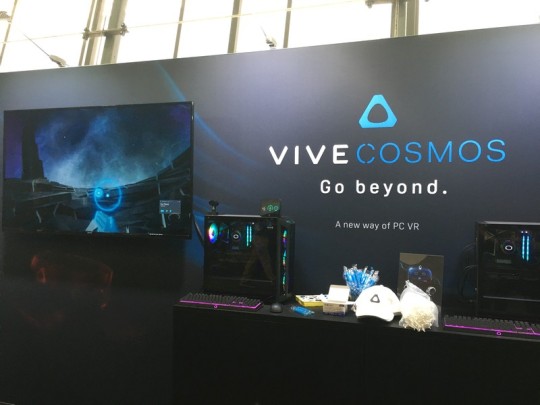
The Vive Cosmos felt really comfy - the lack of cabling and the decent display resolution made it feel a lot more natural than the Gen 1 Vives I've previously used. The game they were using to demo (Audica), however, was pretty lame. A rhythm-target shooter that didn't really take advantage of the medium at all.
Bleeding Edge was not inspiring. It was basically the control point mode from TF2 or Overwatch, except every character was a third-person brawler with little emphasis on projectile weapons beyond the occasional special. It felt like someone making a claim at TF2 or Overwatch's throne several years late while bolting a weak character action game on, which is fairly odd considering how innovative and critically acclaimed Ninja Theory's previous game was.
Dreams is fairly fascinating in its potential. The creation tools weren't available in the demo build so I can’t really judge them, instead there was a choice of eight developer-made experiences ranging from Mario-inspired obstacle courses to videogames as art.
I didn't get the chance to actually play MediEvil, but I watched some folks play it and it basically just looks like the PS1 game with more triangles, with all the slightly wonky 32-bit gameplay that entails.
The demo unit for Monkey King: Hero Is Back had some utterly bizarre graphics settings for some reason that made it look like I was playing a JPEG file, with big whopping compression artifacts surrounding each character. Weird!
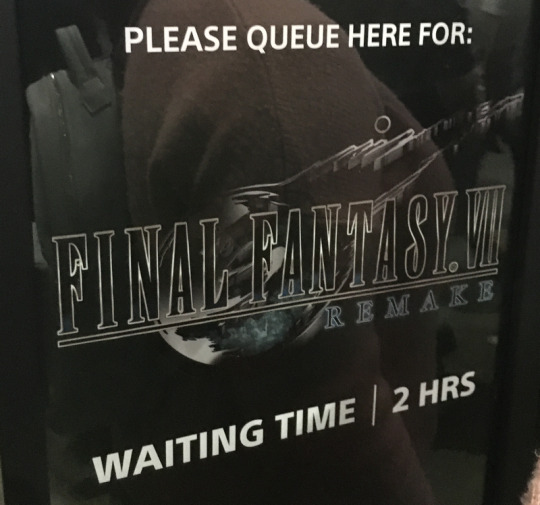
Not happenin’.
Indie Games
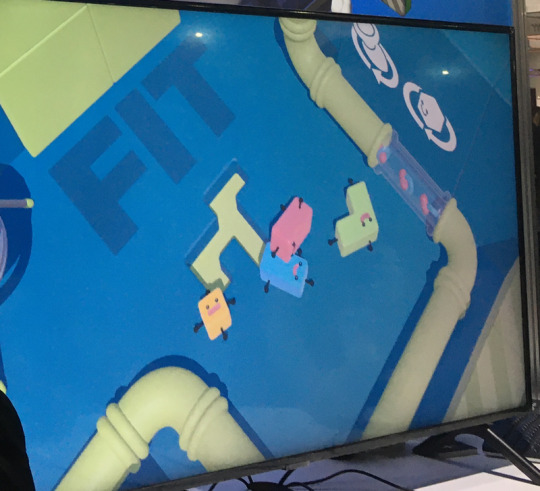
Grabimals is a brilliant local co-op puzzler where players roll around as shapes and link together to solve puzzles like catching a falling water droplet, crossing a gap or casting a shadow that matches an example image. Supposedly it's still a ways off from release, but it's already impressively polished (disregarding one hilarious crash bug we found by accident!)
Hamster Scramble is a really fun take on Puzzle Bobble, with platforming elements, team play and the ability to jump over to your opponent's screen and fuck their plans up directly. It's an absolute blast and didn't feel like it was almost a year away from release.
Fork Knights is a platform fighter with an emphasis on one-hit kills. The character designs are cute, but I can't really say the gameplay itself struck me, to be honest.
Baron is an eight-player single-screen local multiplayer dogfighter. Fairly simple mechanically, but pretty fun all things considered.

Broken Roads had some lovely hand-painted art assets and some interesting ideas like a literal moral compass, but the demo build showcased was waaaaay too early to be shown off to the public. Of the eight or so areas present in the demo, only two had any characters, interactivity or really anything other than wandering around set up, and the combat side of things was extremely rough and sequestered off to a side area as a "well, if you insist..." kind of deal.
Misadventure In Little Lon is a true-crime adventure game for mobile with a unique mechanic - each "scene" is integrated into the real world via AR, with characters (that resemble Poser models more than a little bit) speaking to you directly. Not sure if it holds up over an entire game, but it's attention-garnering at least.
Speaking of true crime, The Black Window tasks players with using an Oujia board to question Australia's first female serial killer, with responses taken from court records and letters from the time. The well-acted performances of the actual individual in question's words lends it an impressive atmosphere, which the booth added to with a big wooden oujia board type thing you could "type" on. Sort of.
ACID KNIFE is real, real early, but the aesthetic is awesome and the pixel art is great. Hopefully it grows and expands into something special.
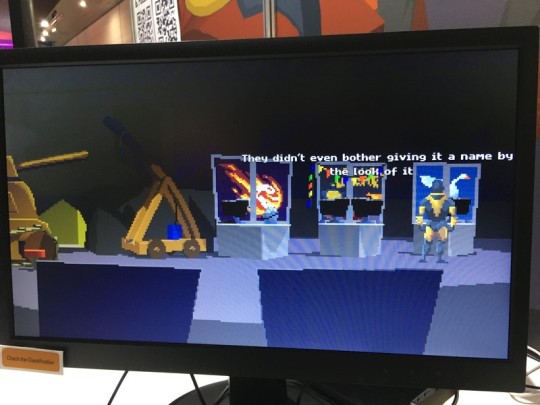
The Vigilante Proclivities of the Longspur is an oldschool Lucasarts-inspired point-and-click adventure with a custom demo scene set at an oddly-familiar videogame convention. Pretty promising so far, but could do with a good bit of polish - I'm pretty sure there was only one sound effect in the entire demo, and dialogue was often lacking in punctuation.
I didn't get to play Hot Brass but I watched over shoulders and talked with the developers, and it looked pretty cool. It's basically a take on SWAT 4's rarely-imitated brand of tactical copwork, but with a Hotline Miami-style top-down perspective, but with all the characters abstracted down to simple board game like tokens - a circle with a coloured outline denoting attitude towards the player, with a weapon icon if armed.
Blood Metal... Blood Metal is not good. It is extensively not good. Development seems to have only started in July, so one can still hope that the bad AI, unsatisfying gunplay, buggy collision detection and complete lack of damage feedback (outside of some ridiculous, sight-obscuring gouts of blood) get fixed over time. The 80s action movie aesthetic and low-poly artstyle forces it to be compared to Maximum Action, which is at least a fun kind of jank...
This Starry Void is a real-time, tile-based 3D dungeon crawler set in an abandoned spacecraft. It seems pretty cool so far, but it could probably use some UI/UX tweaks. The attempts at a "graphic novel inspired" visual style for the environments could probably benefit from looking at how Void Bastards did things, as well.

Lethal Lawns and Beam Team are fucking arcade games with massive cabinets. In 2019. Granted, they're also on computers and coming to consoles and stuff as well, but still! They're both pretty simple games, and therefore best played in cabinet form.
Unpacking is a "zen puzzle game" by the developers of Assault Android Cactus about the second-worst part of moving house, unloading an unseen character's packing and getting a glimpse into their lives as a result. I wasn’t able to play it due to an unexpectedly-crowded booth, but the pixel art is quite lovely.
Feather is a chill game about being a bird and flying around an island trying to find its secrets. I tried the Switch port, which played alright but obviously (and understandably) toted a lower framerate than the demo PC.
Topple Pop is a cute puzzle game that blends together elements of Tetris, Puyo Puyo and that one joke game that was Tetris but with a proper physics engine. Looks cute, with a fun gimmick!
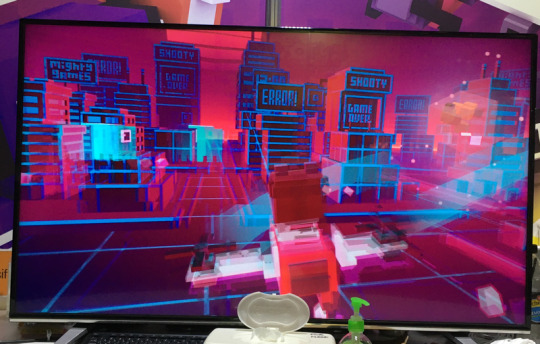
Shooty Skies Overdrive is an VR spinoff of the popular mobile shmup, and basically similar to that one shmup minigame in Valve's The Lab. Weave your plane, which is attached to one of your hands, through incoming bullets and enemies like a toy! The 3D effect on the incoming projectiles looks great, but they can tend to get in the way of the action sometimes.
Dead Static Drive has been at like the last three PAXes and it looks better every time I see it. I hope it comes out this decade.
Snow Mercy is a third-person shooter/strategy thing where you hunt down icecubes to spend on an army of snowmen to crush your opponent's base before they crush yours. Not a common genre combo, reminds me of C&C Renegade a bit.
The Adventure Pals has graphics straight out of mid-2000s Newgrounds and level design out of pretty much any european platformer, but it didn't seem too bad from my brief prodding at it. The player character is perhaps a bit too small for my elderly eyes in Switch portable mode, but that's about as far as my gripes go.
9 notes
·
View notes
Text
Great Content from JSConf Budapest 2019

JSConf Budapest is a JSConf family member 2-day non-profit community conference about JavaScript in the beautiful Budapest, Hungary. RisingStack participated in the conf for several years as well as we did this September.
In 2019 we delivered a workshop called "High-Performance Microservices with GraphQL and Apollo" as our contribution to the event.

Now I'm happy to share the news with you that all conference talks are available online!
Top Picks by the Community:
Essential JavaScript debugging tools for the modern detective by Rebecca Hill
Debugging JavaScript can drive developers crazy. It’s not surprising when so many us stick to the trusty console.log - but there are better ways. From tracking down a critical issue in production, to simply struggling to add a new feature and not realising you’ve misread some documentation - debugging skills are used every day but it's difficult to take the time to improve those skills when the pressure is on.
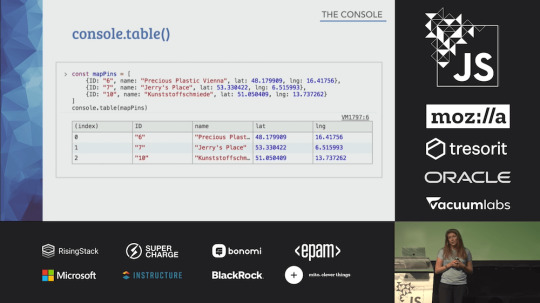
This talk will show you some really handy techniques that will level up your skills of deductive reasoning.
Take on me, web browsers! by Eva Ferreira
In 1985 pop music was mesmerized by the a-ha “Take on me” music video. It’s been almost 35 years since then, the world needs new catchy tunes with impressive video animations… on the web.

In this talk we will explore the bewitching ways we can modify web videos and create immersive experiences worthy of the ‘80s using JavaScript and CSS. Let us swim in the why-not possibility of Chroma key, Rotoscoping and more video animation techniques on the web platform!
API Modernization: Building Bridges As You Cross Them by Shelley Vohr
In an ecosystem undergoing constant flux, what does it mean for an API to be modern?In this talk, I'll discuss the work that's taken place over the last year to deliver modern JavaScript APIs to developers in the Electron project, and the obstacles we encountered along the way.
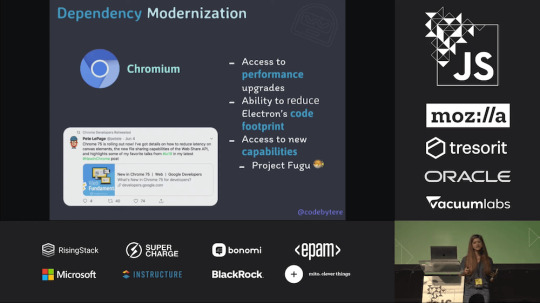
You'll come away with a deeper understanding of how open source projects can more effectively balance innovation with maintenance, as well as perspectives on how to appropriately consider end-users and their needs when modernization affects the code they use.
Check all JSConf videos below:
Accessibility vs latest Web APIs. Can’t we just get along? by Mauricio Palma
Unfortunately, we still treat accessibility in the same way we deal with front-end development for older browsers, something to be done at the end. What if I tell you that we can use the latest Web APIs and still offer an inclusive and accessible experience.
In this talk, you'll learn how to combine Web APIs such as Speech Recognition and Geolocation, with performant Javascript techniques to create empathic user interfaces.
Testing in production: Ideas, experiences, limits, roadblocks by Jorge Marin
Are you afraid of testing in production? Do you test in production? Do you use real data?
By definition testing in production is hard. This talk puts together my experience testing in production a large scale system that affects millions of users. Experience, ideas, limits, roadblocks, tips and more.
Weaving the web - Programming textile-based interactions by Charlie Gerard
What if you could interact with interfaces and devices using your clothes? When we think about wearable garments, we usually think of the technology as an output. We might think of LED dresses or designer-made outfits that react to the environment but what if instead, we used this technology as an input, as a way to interact with other things.
This talk walks you through the process of making interactive clothing using conductive textile. Also Charlie shows what it can do and talks about the possibilities and limits of such technology.
Composing music with composed functions by Adam Giese
Functional programming can be difficult to learn. Although there are many practical lessons, they are often hidden through academic lingo and dry examples. What if these basics could be livened up and taught through the lens of music?
Together, we will go over some of the basics of functional programming including functional array manipulation, closure, immutability, and composing functions. Adam also shows how they can be applied to the creation of music and musical instruments using the web audio API.
How not to read the room: Creating socially awkward wearables by Stephanie Nemeth
I’m introvert. This can be bit unfortunate, when you are a person that enjoys spending a lot of their free time creating things bedazzled with LEDs… only to rarely wear them out in public. ¯\_(ツ)_/¯ In an effort to actually share my weird and wonderful creations with others, I decided create a wearable project that would force me to be sociable in order for it to reveal its magic.
In this talk, Stephanie shares how she used machine learning with javascript and tiny computers to make “fashion” that is responsive to the people around you and the attention you are (or aren’t) receiving.
Taming Git-osaurus Using Mystical Trees by Damini Satya Kammakomati
Raise your hands if you all start to panic when you mess up your local git workflow, trying frantically to save your work and eventually giving in to the complications thereby deleting your repository. Well, Git isn’t the terrible dinosaur you think it is, on the contrary, the messier it becomes, the more interesting it gets.
This session aims to make friends with Git and to express the hidden gems in the mysterious git land which will definitely help you to become more productive and look cool in front of your peers struggling with a git-gone-wild.
Web Norms of the World: An exploration of the internet beyond the West by Kat Kitay
Flat, muted minimalism, vast fields of whitespace, millennial pink landing pages: the internet today, amirite? In this talk, we'll take stock of these biases and take a culturally relativistic look at the internet outside of our comfort zone. We'll explore questions like: Why are Japanese websites so information-dense? How does a script like Arabic, read right to left, affect web design? What languages do (or can) programmers across the world use?
The viewers of this talk will walk away with a fresh perspective and ideas for improving our web and making technology that's more inclusive of a global audience.
Legendary Lambdas by Tejas Kumar
The Serverless paradigm is one that is slowly taking over the internet. This talk dives deep into Serverless, particularly Serverless Lambda Functions, and their benefits and drawbacks to web applications. We will also discuss how they can benefit business, being extremely cheap to implement and maintain.
As a practical, technical case study, we will examine serverless performance across a number of popular front-end UI frameworks and measure various metrics relevant to a serverless application.
Mastering UIs with Finite State Machines by Rubén Sospedra
Did you ever feel like monkey patching your UI component? Adding too many if/else, handling a lot of complexity or hacking several non-desired side effects. Did you ever have a problem with double-clicking an async button? Fetching multiple times the same resource in a row? Did you have problems translating UX interfaces and mock-ups into your applications scenes?
All this kind of problems can be properly fixed by applying a different point of view. An architecture based upon Mealy state machines. Also known as finite state machines or automatas. These machines are deterministic, pure and idempotents. Opening a new set of possibilities from predictable components to autogenerated tests.
Deciphering Brainwaves with the Web Audio API by Braden Moore
Early last year, my colleagues and I did something amazing — using only JavaScript, the browser, and the Web Audio API, we were able to decipher brainwaves. It sounds sensational, but it’s (mostly) true. This is a story about how we converted brainwaves into audio signals — and then back again — to solve the problem of epilepsy diagnosis on the web.
In this talk, you’ll get to see a new browser API being used in a novel and unprecedented way, combined with world-leading innovations in the field of epilepsy diagnosis. You’ll learn about the challenges of real-time brainwave filtering and how we solved them. As you’ll see, the technologies we use each day can sometimes be applied in unexpected ways.
A privacy first period tracker? Is it even possible? by Benedicte Raae
Do I want to track my cycles? Yes. Do I want the tracker to push my data to a third party? Hell NO! Do I want the data lying around unencrypted in a database somewhere? Not really. Do I want backup and access from multiple devices? Kinda.. What would I need to learn and is it even possible?
Learn how Benedicte created a secure and private web-based period tracker.
StrangerDanger: Finding Security Vulnerabilities Before They Find You! by Liran Tal
Open source modules on the NPM ecosystem are undoubtedly awesome. However, they also represent an undeniable and massive risk. You’re introducing someone else’s code into your system, often with little or no scrutiny. The wrong package can introduce severe vulnerabilities into your application, exposing your application and your user's data.
This talk will use a sample application, Goof, which uses various vulnerable dependencies, which we will exploit as an attacker would. For each issue, we'll explain why it happened, show its impact, and – most importantly – see how to avoid or fix it.
Testing presentation components visually by Balázs Korossy-Khayll
You have written all the unit tests, integration and e2e tests imaginable to your project, your code coverage is in the skies, you are sure that everything is in working order, your application is ready to ship. Or is it? Frontend developers often face the challenge that even a plethora of tests don’t cover visual differences, and while the functionality might be working and protected by tests, we don’t know much about the layout’s and visual styles’ correctness.
Writing unit tests or manual testing for visual styles is tiresome and error-prone, so at BlackRock we came up with a better solution. Using Storybook we have developed a way of comparing visual differences of the rendered images of our presentational components.
Great Content from JSConf Budapest 2019 published first on https://koresolpage.tumblr.com/
0 notes